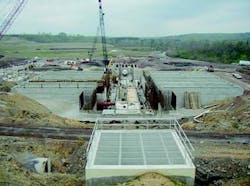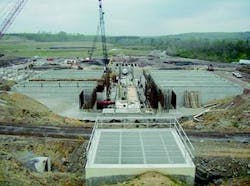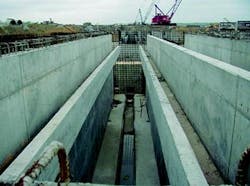New Filter System Successfully Treats Stormwater Flows
By Gregory Ellard
Jefferson County, AL, has begun a major effort to improve effluent quality from its Village Creek Wastewater Treatment Plant during wet weather conditions. Infiltration, the seepage of groundwater into the sewer system, causes an increased flow to the plant, from 30 mgd to as much as 360 mgd. In the past, exceeding plant hydraulic capacity of 60 mgd required a bypass for the rest of the sanitary sewer overflow (SSO) directly to Village Creek, a stream that crosses northern Birmingham and feeds Bayview Lake in the western part of the county.
According to the Birmingham News, "the Alabama Department of Environmental Management lists Bayview as an impaired [lake], with high levels of ammonia, silt, pesticides and a lack of dissolved oxygen...Village Creek showed much the same pollution levels as Bayview."
City and county officials working with residents recognize a value in the future recreational potential of the lake and creek and have allocated millions of dollars to make improvements.
In the summer of 2000, Jefferson County and its consulting engineer, Gary L. Owen & Associates, arranged to perform a pilot test using deep bed filtration as the primary means of treatment during infiltration from wet weather at the Village Creek Wastewater Plant. A large filter pilot plant provided by Severn Trent Services underwent a variety of tests over the course of two months and successfully treated over one million gallons of wastewater.
The pilot plant was positioned next to a source of raw plant influent near the front of the treatment plant. Then, raw wastewater was piped to a mixing tank where the addition of plant re-use water adjusted the total suspended solids (TSS) content enough to simulate projected wet weather conditions. A submersible pump was placed in the tank to supply wastewater to the pilot plant, passing the flow through an in-line mixer (for possible chemical addition) and a flowmeter before reaching the top of the filter. Typically, submersible pumps do not require the addition of a flowmeter except in pilot test situations where accurate flow must be ensured.
The pilot plant contained two 10-square-foot filters, each housing a six-foot depth of large rounded sand filter media. Very short water-only backwashes were employed to control head loss. When needed, the filters were vigorously backwashed with a combination of air and water. Automatic samplers collected filter influent and effluent composites for each filter run.
Various flow and solids loadings and operating techniques were evaluated over the two-month test period. To address future design needs, the engineering design team focused on loading the pilot plant filters with about 100 mg/L TSS wastewater at 10 gallons per minute per square foot of filtration area (100 gallons per minute per 10 square foot filter cell).
This represented applied loading rates two to four times higher than previously tested, requiring the development of new operating and backwashing methods to maintain flow. Monthly average effluent requirements were 30 mg/L TSS and 25 mg/L CBOD. Results from several weeks of testing were encouraging:
Influent TSS ranged from 37 to 197 mg/L and averaged 94 mg/L. Influent CBOD ranged from 28 to 92 mg/L and averaged 49 mg/L. After treatment, effluent TSS ranged from 7 to 18 mg/L, and average 12 mg/L; effluent CBOD ranged from 10 to 26 mg/L and averaged 17 mg/L.
Pilot results successfully met monthly average effluent requirements and showed that the best effluent and longest filter runs were achieved with no chemical addition. Further testing simulated the "first flush" of the collection system by continuously applying operating and backwashing methods of 200 to 500 mg/L TSS undiluted raw wastewater to the filters at about 5 gallons per minute per square foot. Test results still produced effluent quality of about 40 mg/L TSS, below the projected weekly permit average of 45 mg/L.
With the success of the pilot study, Village Creek WWTP commissioned a full-scale filtration plant in early 2001 with completion set for 2003. The final plant design incorporates a layout of two filter trains consisting of 22 filters, each at 1167 square feet, designed with more freeboard than the pilot filters.
New control methods, some patent-pending, and innovative piping designs will allow continuous, rolling execution of two simultaneous air/water backwashes and four water-only backwashes to proceed at the same time to control head loss through the filters and expel excess solids during wet weather events. These events will peak at up to 360 mgd for four hours, with elevated flows persisting for as much as 24 hours. In dry periods, the filters will polish existing plant effluent to tertiary standards.
The new construction also includes an interceptor box on the main sewer so that storm surges may be diverted around it. The interceptor box discharges into a long bypass tunnel ending at a new pump station supplying the 24 surge basins and new filters. Final effluent is treated by ultraviolet disinfection before discharge to Village Creek.
This new facility provides secondary effluent quality in a single, high rate treatment step. It is an innovative solution to the search for effective methods to receive and treat flows from infiltration, CSOs and SSOs.
About the Author
Gregory Ellard, project engineer for Severn Trent Services has contributed to design, startup and service of over 100 plants and treatment systems with over 15 years of experience in the water and wastewater industry. He holds both a B.S. and M.S. in chemical engineering. He can be reached at 813.886.9331 or [email protected].


